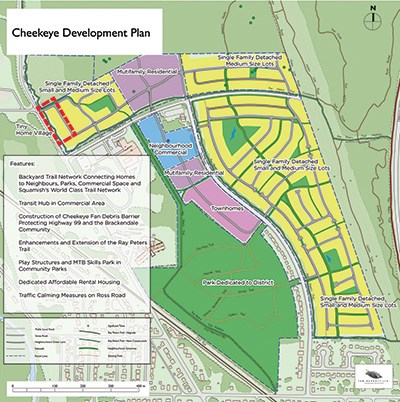It was a strong show of support for the Cheekye River Development proposal.
Speaker after speaker stood at the microphone to express support for the proposed 1,215-unit Brackendale housing development at a four-hour public hearing held at Howe Sound Secondary School on Tuesday night.
The project is proposed for 81 hectares in the area of Ross and Government roads.
Of the 60 residents and business owners who addressed council at the hearing, almost all voiced support for the project. Many noted the need for affordable housing in Squamish and the jobs the project would provide over its 20-year build out.
The homes would likely be offered to those with local addresses first for a period of time, according to the developer.
Of the units proposed by Cornerstone Developments – a partnership between the Squamish Nation and developers Bethel and Matthews Southwest – 537 would be single-family units and 678 would be multi-unit dwellings, according to a report to council. An area for “tiny homes” is also proposed as well as about 13,000 square feet of commercial space.
The development will also include purpose-built rental housing, with the developer contributing $4.26 million toward it.
A 20-hectare Brackendale Farmers Institute Park is also included.
The overwhelmingly supportive audience of about 200 that overflowed the school’s Eagle Eye Theatre was made up of many members of the Squamish Nation and its leadership, including hereditary Chief Ian Campbell, members of the Nation’s chiefs and council and elders.
“For far too long we have been invisible in our own land. [With] the arrival of settlers in this part of the world, we have seen great impacts to our way of life, to our tradition, our culture, our language and our economy. What I am pleased this evening is to see the potential for reconciliation in action,” said Campbell.
“To see our partners, Michael Hutchison… have a vision and to walk through the regulative process together to look at a potential development that will not only benefit the district, but all of our children and grandchildren for the foreseeable future.”
Support was also offered by numerous other Squamish business owners and trades people, such as Adam Smith, a Squamish-based homebuilder.
“We can all agree we have an affordable single-family housing issue here. This will not be changed until we have more inventory,” he said.
“This brings more inventory to the market and inevitably people will have choice and prices will hopefully flatten out and things will become more realistic.”
Smith, like other local business speakers, noted that more Squamish trades people would be employed were the project to go ahead because the developer has a history of hiring local whenever possible.
“This is going to provide long-lasting jobs for people in my industry in town,” Smith added.
The entire development will be completed within the debris flow hazard zone. The developer has offered to build the approximately $45-million debris flow structure.
It was proposed at the meeting Tuesday that a local service area may be created to tax only those within the development area to pay for the operating and maintenance costs of the barrier.
The District of Squamish, perhaps through a local government corporation, would have ownership of the barrier.
Including the rental housing and the barrier, the developer offered $72.2 million worth of community amenity contributions, according to District staff.
Some speakers spoke of how many have and continue to live in risk on the Cheekye Fan and noted the debris flow barrier – or berm – would protect many in Brackendale, not just those in the new development.
“I remember as a young boy, we were the first house to build up there and our bedrooms used to literally shake from the rocks coming down the Cheekye River,” said Randall Lewis, who grew up in Brackendale.
“Without the berm, we are at risk. With the berm, the risk is less.”
Experts have told the district that some forme of mitigation has to ultimately be built, regardless of any new development. *
Rachel Shephard was one of the rare speakers to oppose the project. She expressed several concerns including potential habitat loss, the unknown impact of the massive debris flow barrier – which will be among the largest of its type in the world, she said – the financial risk to the district should there be a major landslide event and the risk of putting more people into a high-hazard area.
“I do not support this development,” she said.
Council has passed first and second readings of an Official Community Plan amendment and the rezoning bylaw required for the project.
The project will be back before a future council for third reading.
*Please note this story has been corrected since it was first posted. The district was told by experts some form of mitigation needs to be done, regardless of new development, but they did not say a barrier in particular had to be built.



